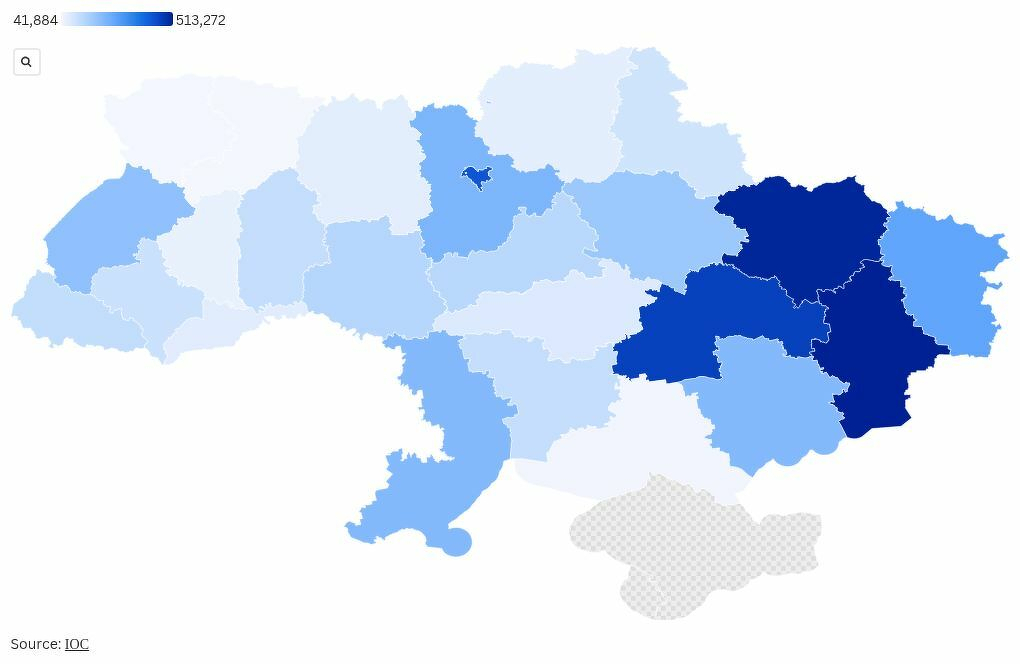Today, there are between 3.5 and 4.5 million internally displaced persons (IDPs) in Ukraine. What support does the state provide and is it sufficient to help IDPs integrate into their new communities?
How many IDPs are there in Ukraine?
The law On Ensuring the Rights and Freedoms of Internally Displaced Persons (IDPs) defines an IDP as a citizen of Ukraine, a foreign national, or a stateless person who is lawfully present in Ukraine, has the right to permanent residence, and was forced to leave or abandon their place of residence due to “the adverse effects of armed conflict, temporary occupation, widespread violence, human-rights violations, or emergencies of a natural or man-made nature”.
Since 2014, IDP status has been available to those who left Donetsk, Luhansk, and Crimea, and following Russia’s full-scale invasion, anyone who left home because of the war and settled elsewhere within Ukraine can register as an IDP (even if they moved from one community to another within the same region).
Data on the number of IDPs in Ukraine vary significantly across sources. As of April 2025, the International Organization for Migration estimated about 3.76 million IDPs in Ukraine. At the same time, according to the Information and Computing Center (ICC) of the Ministry of Social Policy, as of September 10, there were 4.57 million officially registered IDPs. The Kyiv School of Economics explains that the former figure is closer to reality, since many IDPs do not deregister after returning home or moving abroad. Nevertheless, state policy currently relies on the ICC’s data. According to these figures, the Donetsk, Kharkiv, and Dnipropetrovsk regions have the highest numbers of people forced to leave their homes because of the war (Figure 1).
Figure 1. Number of registered IDPs by regions as of late September 2025

The state provides IDPs with financial, housing, and social support through several programs.
Financial assistance
The state pays IDPs a monthly allowance – UAH 2,000 per adult and UAH 3,000 per child or person with a disability – for six months after IDP registration (in August 2025, 1.2 million people received this assistance). During the first three months after the allowance is granted, recipients are required to take steps toward employment, such as finding a job or registering as unemployed. Without this, payments stop after the three-month period. Assistance may be extended for an additional six months, but only for categories specified by law. It is extended automatically for older adults with low pensions, persons with disabilities, seriously ill children, orphans, or children deprived of parental care, as well as foster parents and family-type caregivers. Upon application, extensions may also be granted to low-income persons, people over 55, those registered with the Employment Center, students, and other eligible groups.
The eRecovery program allows IDPs to receive compensation for damaged or destroyed housing, including homes located in occupied territories. In addition, IDPs from temporarily occupied territories can receive up to UAH 2 million to purchase new housing.
Housing assistance
Cabinet Resolution No. 409 (2014) allows IDPs to rent housing at the state’s expense for up to one year. IDPs may use this option if they do not own housing or if their living space is less than 13.65 m² per person or 35.22 m² per household.
Since January 29, 2025, the government has introduced a new rent-subsidy mechanism. Individuals who spend more than 20% of their income on rent can receive a subsidy, calculated so that their rent expenses do not exceed 20% of their income. The amount of the subsidy can be determined using a special online calculator.
Previously, the subsidy was granted for one year, with the option to reapply after the initial period expired. It is now granted for six months, with automatic extension provided the recipient retains IDP status. In calculating the subsidy, an updated benchmark for the average rent rate is applied (UAH 208/m² from January 2025 instead of UAH 193.6/m² previously). Additionally, housing can now be rented either in full or in part.
In addition, the government has pledged to reimburse taxes to homeowners who rent housing to IDPs. Homeowners will be refunded personal income tax and the military levy on rental income, while individual entrepreneurs (FOPs) will be compensated for the single tax based on the social rent rate, as well as the military levy.
Social assistance
A number of benefits are available for children who are IDPs. They have priority admission to state and municipal preschools and schools: the right to free meals in educational institutions upon presentation of an IDP certificate or confirmation of a child’s status as affected by war and the right to free health rehabilitation or recreation.
Students under 23 who are IDPs may be eligible for a social scholarship if they study full-time on a state-funded basis, are included in the academic performance ranking, and have no outstanding academic debts. They have priority for dormitory placement and are entitled to discounted dormitory fees. In addition, children of IDPs and those living in frontline communities who study on a fee-paying basis may obtain concessional student loans.
The State Employment Center offers IDPs opportunities for retraining or training vouchers of up to UAH 30,280. Employers who hire IDPs receive compensation equal to the minimum wage for up to six months.
Since 2023, the government has implemented a pilot project providing comprehensive social services (housing, social adaptation, and care) for persons with disabilities and older adults among IDPs.
Beyond the state, international organizations, such as the UNHCR, and civic initiatives make a significant contribution to providing humanitarian aid, housing, and social services for IDPs: today, more than 550 organizations support displaced persons on the ground.
How effective is this assistance?
Despite the range of support programs, for many IDPs, they ensure only survival. The scale of destruction and loss far exceeds the capacity of both the state and the communities hosting displaced people. For instance, a 2025 study by Stabilisation Support Services found that in most communities, housing programs do not cover even half of actual needs. In Kyiv, as of March 2025, more than 424,000 IDPs were registered and among 2,864 families who applied for temporary housing, only 115 families (392 people) received it. Clearly, problems persist even in the wealthiest communities.
This is unsurprising, as more than 2.5 million homes or 13% of the entire housing stock have been destroyed or damaged. Under these conditions, even the most ambitious initiatives, such as eRecovery, can address only targeted needs, since they focus on repairing or purchasing housing for individual families rather than on the comprehensive restoration of housing infrastructure. As a result, temporary solutions (such as shelters and dormitories) become permanent, undermining not only the quality of life but also trust in the recovery policy. In 2025, more than 79,000 of the most vulnerable IDPs lived in nearly 1,800 temporary accommodation sites, where conditions remain difficult.
According to a 2024 survey, 56% of IDPs struggle to meet even basic needs (food and clothing). IOM data show that one-third of IDPs cannot afford basic food items, 44% cannot afford medicines, and another 32% cannot afford clothing even while receiving social benefits. IDPs also report difficulties with renting housing, including high rents, and with finding jobs, with 11% citing employment obstacles specifically due to their IDP status. According to OECD research, only about 40% of working-age IDPs are employed or self-employed, compared with 50% in the general population.
A survey of IDPs conducted by the Ministry of Social Policy found that only 28% support themselves through earnings, while 63% depend on state assistance. However, this does not mean that most IDPs are unwilling to work—factors such as age, health, caregiving responsibilities, and the departure of many of the most mobile and employable abroad may all play a role.
The lack of housing and employment can hinder IDPs’ integration into new communities. For example, a 2025 survey in the Vinnytsia region found that only 44% of IDPs consider themselves fully integrated, 42% partially integrated, while 14% remain isolated from community life. At the same time, 76% rent housing, 20% live in temporary accommodation, and only 4% own their homes.
IDPs, especially those who have settled in smaller communities (for example, because housing is cheaper there or relatives can host them), may fall into a “poverty trap”, meaning they have enough to survive but lack the social services or “start-up capital” needed to move out of vulnerability. This issue is urgent: the longer a person remains in such a situation, the harder it becomes to return to the labor market.
What should be done?
In our view, since the number of IDPs is unlikely to decrease in the coming years (70% do not plan to return, typically because returning is impossible), a long-term (five- to ten-year) strategy for integrating IDPs into new communities must be developed at the national level with the participation of local authorities. The previous strategy expires this year. In our view, such a strategy should include the following measures:
- Long-term housing provision: for example, expanding eRecovery to include the construction of houses or even residential neighborhoods. The housing supply for IDPs can be increased not only through incentives for landlords but also by raising taxes on unused housing. This would encourage owners to rent it out or increase local budget revenues;
- Expansion of comprehensive social-service programs whose ultimate goal is to enable households to move out of vulnerability. This will require investment in local social services;
- Development of retraining and vocational and technical education programs that take into account regional labor-market needs;
- Creation of spaces for community interaction so that IDPs (and long-time residents alike) can strengthen their social capital. Libraries, for instance, can serve as such hubs.
Implementing these proposals will require resources. Funding may come from international organizations or partner governments. It is equally important to use existing resources more efficiently: to provide support that is more targeted and delivered in formats with long-term impact, helping IDPs move beyond the “temporariness” trap. When designing and evaluating support programs, it is crucial to rely on survey data without continuous impact monitoring and feedback, as much of the available funding risks being wasted.
Photo: depositphotos.com/ua
